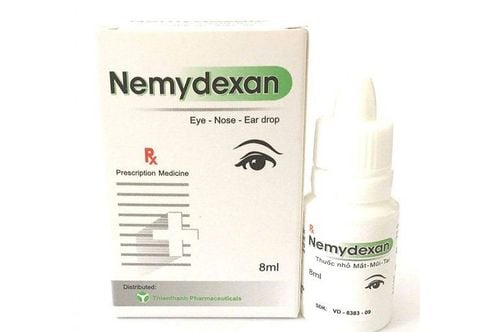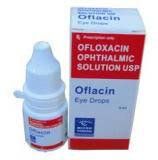This is an automatically translated article.
Haiphadexa drug has the main active ingredient chloramphenicol with the content of 20mg and Dexamethasone sodium phosphate with the content of 5mg. The drug is used in the treatment of eye diseases such as acute conjunctivitis, corneal ulcers, lacrimal gland infections, eyelid inflammation, ...
1. What is Haiphadexa?
What is Haiphadexa drug? Haiphadexa drug has the main active ingredient chloramphenicol with the content of 20mg and dexamethasone sodium phosphate with the content of 5mg. The drug is used in the treatment of eye diseases such as acute conjunctivitis, corneal ulcers, lacrimal gland infections, eyelid inflammation, ...
Haiphadexa drug is prepared in the form of eye drops. Packing is a medicine box with 1 bottle of 5ml.
1.1. Chloramphenicol ingredient information 1.1.1. Pharmacodynamics of active ingredient Chloramphenicol Active ingredient Chloramphenicol is an antibiotic isolated from Streptomyces venezuelae, now produced by synthetic method.
1.1.2. Pharmacokinetics of the active ingredient Chloramphenicol Absorption: Active ingredient Chloramphenicol is rapidly absorbed from the gastrointestinal tract. Chloramphenicol palmitate hydrolyzes in the gastrointestinal tract and is absorbed as free chloramphenicol. After topical application in the eye, the active substance chloramphenicol is absorbed into the aqueous humor. Distribution: Active ingredient Chloramphenicol is widely distributed in most body tissues including saliva, ascites, pleural fluid, synovial fluid, aqueous humor and vitreous humor. The highest drug concentrations exist in the liver and kidneys. Chloramphenicol is about 60% bound to plasma proteins. Metabolism: Active substance Chloramphenicol is inactivated mainly in the liver by glucuronyl transferase. Elimination: Approximately 68-99% of an oral dose of Chloramphenicol is excreted in the urine in 3 days. 1.1.3. The action of the active ingredient Chloramphenicol Pharmacokinetics Chloramphenicol is usually bacteriostatic, but can be bactericidal at high concentrations or against highly susceptible bacteria. Chloramphenicol inhibits protein synthesis in susceptible bacteria by binding to the 50S subunit of the ribosome. At the same time, this drug also inhibits protein synthesis in rapidly proliferating mammalian cells. Chloramphenicol may cause bone marrow suppression and may be irreversible. The drug has no effect on Shigella flexneri, Escherichia coli, Enterobacter spp., Staphylococcus aureus, Salmonella typhi, Streptococcus pneumoniae and has little effect on fungi. 1.2. Dexamethasone ingredient information 1.2.1. Pharmacokinetics of the active ingredient Dexamethasone Dexamethasone is fluomethylprednisolone which is a synthetic glucocorticoid, almost insoluble in water.
1.2.2. Pharmacokinetics of the active ingredient Dexamethasone Absorption: The drug Dexamethasone is well absorbed from the gastrointestinal tract, well absorbed at the site of administration. The drug is highly absorbed by the kidneys, liver and adrenal glands. Distribution: The drug is distributed into all tissues of the body, crosses the placenta and small amounts are excreted in breast milk. The drug is also bound to plasma proteins up to 77% and mainly to albumin. Metabolism: Dexamethasone is metabolized slowly in the liver. Elimination: Dexamethasone is excreted in the urine, mostly in the form of unconjugated steroids. The mean half-life is about 36 to 54 hours. 1.2.3. The action of the active ingredient Dexamethasone Active ingredient Dexamethasone works by binding to receptors in the cell, translocating into the cell nucleus and there affecting a number of genes to be translated. Dexamethasone active ingredient has anti-inflammatory, anti-allergic and immunosuppressive effects. The effect on electrolyte balance is minimal. In terms of anti-inflammatory activity, Dexamethasone is 30 times stronger than Hydrocortisone. At pharmacological doses, systemic administration of dexamethasone causes suppression of the pituitary gland causing corticotropin release (ACTH), causing the adrenal cortex to stop secreting endogenous corticosteroid hormones, causing secondary adrenocortical insufficiency.
2. What are the effects of Haiphadexa?
Haiphadexa drug is indicated in the treatment of pathologies as follows:
Treatment of corneal ulcers, infection of the lacrimal gland, acute conjunctivitis, eyelid inflammation. Prophylaxis of infections before and after eye surgery, chemical burns and other burns. Treatment of serious infections caused by susceptible bacteria, meningitis and other infections caused by Haemophilus influenzae when Aminopenicillin, Gentamicin and some 3rd generation Cephalosporin antibiotics are ineffective or contraindicated. Bacterial infections caused by Rickettsia when tetracyclines cannot be used. Trachoma and eye shingles. Irrigation of the tear drainage system for therapeutic or prophylactic purposes.
3. Usage and dosage of Haiphadexa
How to use and dose of Haiphadexa drug as follows:
Haiphadexa drug is prepared in the form of eye drops, suitable for use by instilling directly into the eyes. Dosage for adults: Haiphadexa drug 1 to 2 drops / time, 2 to 4 times a day. In the acute stage of disease: instill 1 drop/hour. The duration of treatment is about 10 days. Dosage for children: There are currently no recommendations for use in children.
4. Undesirable effects of Haiphadexa drug
During the use of Haiphadexa, patients may experience rare unwanted effects such as local irritation, allergies, transient mild pain, bitter taste when entering the mouth. In particular, there is a partial irreversible blood dysplasia effect, reversible neuritis.
You need to actively inform your treating doctor or medical professionals if you experience other serious side effects while using Haiphadexa.
5. Haiphadexa drug interactions
To avoid Haiphadexa drug interactions, patients need to inform their doctors about the drugs, herbs, and health care products they are using so that the doctor can consider and prescribe them appropriately.
6. Some notes when using Haiphadexa drug
During the use of Haiphadexa, patients should pay attention to the following issues:
6.1. Contraindications of the drug Haiphadexa Contraindications of the drug Haiphadexa in the following cases:
People with a physical hypersensitivity or hypersensitivity to Dexamethasone or Chloramphenicol components. People with bone marrow failure, infants. People with viral or fungal infections of the eye, tuberculosis or glaucoma. 6.2. Precautions while using Haiphadexa drug should be used with caution in pregnant and lactating women. Do not take Haiphadexa for a long time. Above is all information about Haiphadexa drug, patients need to carefully read the instructions for use, consult a doctor / pharmacist before using. Absolutely do not arbitrarily buy Haiphadexa to treat diseases at home, because there may be unwanted side effects on health.
Follow Vinmec International General Hospital website to get more health, nutrition and beauty information to protect the health of yourself and your loved ones in your family.













